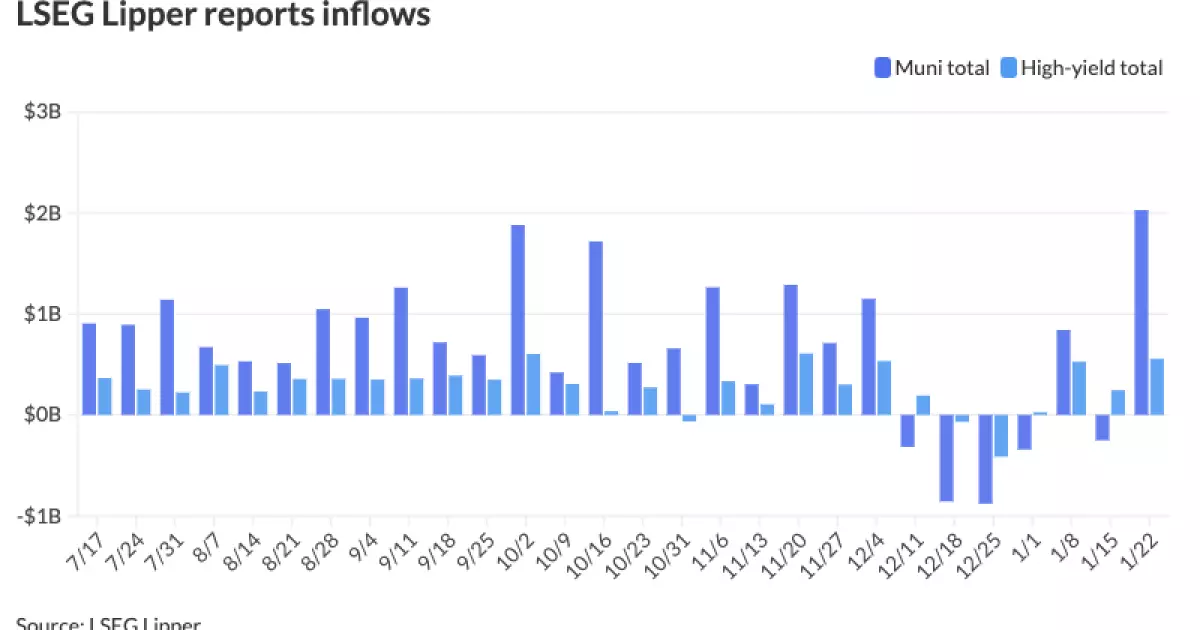Municipal bonds have recently seen a unique interplay of dynamics, where seemingly adverse conditions have prompted a surprising resilience among market participants. As investors navigate through these intricate conditions, a deeper analysis can shed light on the ongoing trends that are shaping the municipal bond landscape.
On Thursday, the municipal bond sector encountered a slight setback, reflected in weaker bond prices despite the attractive inflows surpassing $2 billion into muni mutual funds. This influx indicates a growing investor appetite for municipal bonds, even as the primary market activity appeared to slow. Meanwhile, U.S. Treasury yields experienced an uptick from the five-year mark and beyond, contributing to mixed performances in equities. As of the close of trading, the yield ratios between municipal bonds and U.S. Treasuries (UST) exhibited consistency, leading to a 64% ratio for the two-year and five-year maturities, a 66% ratio for the 10-year, and an 83% ratio for the 30-year bonds.
These statistics indicate a balanced market where demand remains robust despite supply concerns. Fixed-income analysts have noted that the absence of significant competitive offerings does not deter interest from bidders, who are instead focusing on the yield opportunities present in the current environment. Kim Olsan, a senior portfolio manager at NewSquare Capital, underscores this point by highlighting that the yields, in many instances, have moved lower even in the context of increased issuance.
The current landscape suggests a critical divergence between supply and demand fundamentals. While there has been larger issuance of bonds and lower redemption rates, investor sentiment appears to be oriented towards positive yield prospects rather than the broader supply concerns. Olsan explains that a rare cluster of high-quality issuances on the market allows buyers to find favorable offerings, exposing them to tighter spreads that could potentially yield higher returns. For context, bonds from Washington state and Nevada were able to secure narrower spreads, suggesting strong demand despite market uncertainties.
Interestingly, the primary market’s activity is indicative of this trend. Notably, the pricing structures seen in a recent Massachusetts Development Finance Agency bond issue reveal spreads significantly tighter than historical averages. Olsan identifies that the competitive environment, despite a decline in daily trading volumes, is still conducive to wider spread opportunities and nuanced trading dynamics.
The behavior exhibited by investors during this period reinforces the notion of cautious optimism. The week ending Wednesday observed inflows into municipal bond mutual funds reaching a substantial $2 billion, marking a pronounced shift from the previous week’s outflows. Concurrently, high-yield funds also observed promising inflows, resulting in a robust interest across all rating categories. This diversification of interest reflects an increased investor confidence in navigating the complexities of the current market.
While tax-exempt municipal money market funds saw total assets dip due to some outflows, the overall market appears to be rallying as yields continue to decline. The data marks a clear preference among investors for high-rated municipal assets, with AAA and AA categories accounting for a significant portion of trading activity this month.
As we look ahead, several factors merit consideration for potential market movements. Olsan highlights that January has already yielded modest outperformance in the higher-rated categories, which raises questions regarding sustainable momentum as we enter the next months. Notably, Baa-rated and single-A categories are showing promise with slight positive returns, emphasizing the potential for broader market stability.
Nevertheless, the backdrop of fluctuating UST yields will likely influence decision-making in the coming weeks. The continuous reassessment of credit quality amid a landscape of increased municipal issuance, alongside investor behavior indicating caution, showcases the complexities facing market stakeholders.
The municipal bond market stands at a critical juncture where supply and demand fundamentals are being tested. While investors navigate through an evolving landscape, the interplay between improved yields, high-quality offerings, and cautious flows suggests a resilient market geared towards optimizing investment strategies. Going forward, market participants will undoubtedly remain vigilant around new information and shifts within the broader economic environment that could impact municipal bond valuations.

